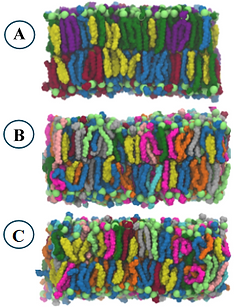How to Cite This article
Marco Cavaglià, Silvia Vernuccio and Jack Tuszynski (2025). Exploring the role of phospholipid membrane composition in biomolecular simulations: towards tailored membrane models. Journal of Multiscale Neuroscience, 4(2): 107-119.
DOI: https://doi.org/10.56280/1702405472

Authors Affiliation
Marco Cavaglià
Bioengineering Group, Polytechnic University of Torino, Turin 10129, Italy.
Silvia Vernuccio
Department of Mechanical and Aerospace Engineering (DIMEAS),
Jack Tuszynski
Bioengineering Group, Polytechnic University of Torino, Turin 10129, Italy.
Received 29 May 2025
Accepted 26 June 2025
Online published 28 June 2025
ORIGINAL RESEARCH
Exploring the role of phospholipid membrane composition in biomolecular simulations: towards tailored membrane models.
Publication: Journal of Multiscale Neuroscience DOI: https://doi.org/10.56280/1702405472
Abstract
Cell membranes are highly complex biological systems composed of a wide array of lipid species, distributed asymmetrically across the bilayer leaflets. This highly specific lipid composition is essential for maintaining membrane integrity and functionality, yet simplified models are often used in molecular dynamics (MD) simulations. Such simplifications might lead to inaccurate representations of the structural and functional characteristics of the membrane. In this study, we compare a generic mammalian membrane model with two brain-specific neuronal membrane models to assess the impact of lipid composition on simulation outcomes. By combining experimental data and earlier computational models, we developed consensus models representing the membrane of the neuronal soma and the synaptic plasma membrane, using lipids with readily available and validated molecular mechanics parameters in the CHARMM36 force field. MD simulations revealed distinct structural and mechanical properties in brain-specific membranes, including increased area per lipid, reduced membrane thickness, and lower bending stiffness, compared to generic membranes. These differences are expected to influence the behaviour of embedded proteins and the membrane's response to electrochemical signals, underscoring the functional significance of lipid diversity. In particular, the bending modulus Kc was markedly reduced in brain-specific models (Kc=51.47 kBT and Kc=47.87 kBT for soma and synaptic membranes, respectively) compared to the average mammalian cell membrane model (Kc=89.80 kBT), reflecting increased membrane flexibility. These findings underscore the importance of utilizing tissue-specific membrane models to obtain biologically accurate insights in MD simulations.
Keyword: molecular dynamics, molecular models, cell membranes, membrane mechanics, lipid composition, neuronal membranes, electrostatics.
Conflict of Interest
The authors declare no conflict of interest
Copyright: © 2025 The Author(s). Published by Neural Press.
This is an open access article distributed under the terms and conditions of the CC BY 4.0 license.
Disclaimer: All claims expressed in this article are solely those of the authors and do not necessarily represent those of their affiliated organizations, or those of the publisher, Neural Press™ or the editors, and the reviewers. Any product that may be evaluated in this article, or claim that made by its manufacturer, is not guaranteed or endorsed by the publisher.
References:
Abraham, M.J., Murtola, T., Schulz, R., Páll, S., Smith, J.C., Hess, B. and Lindahl, E. (2015) GROMACS: High performance molecular simulations through multi-level parallelism from laptops to supercomputers. SoftwareX 1–2, 19–25.
Arriaga, L.R., López-Montero, I., Rodríguez-García, R., Bagatolli, L.A., Monroy, F. and Langevin, D. (2017) Dissipative dynamics of cholesterol-enriched lipid membranes. Advances in Colloid and Interface Science 247,514–520.
Berendsen, H.J.C., Postma, J.P.M., van Gunsteren, W.F., DiNola, A. and Haak, J.R. (1984) Molecular dynamics with coupling to an external bath. Journal of Chemical Physics 81, 3684–3690.
Biasini, M., Bienert, S., Waterhouse, A., Arnold, K., Studer, G., Schmidt, T., Kiefer, F., Gallo Cassarino, T., Bertoni, M., Bordoli, L. and Schwede, T. (2010) OpenStructure: a flexible software framework for computational structural biology. Bioinformatics 26,2626–2628.
Biasini, M., Schmidt, T., Bienert, S., Mariani, V., Studer, G., Haas, J. and Schwede, T. (2013) OpenStructure: an integrated software framework for computational structural biology. Acta Crystallographica Section D 69,701–709

.png)